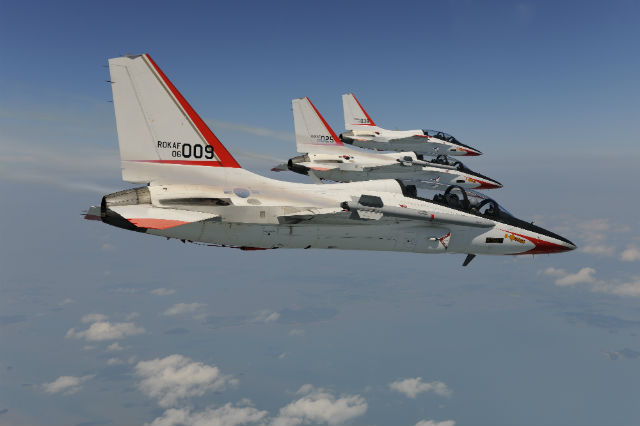In the 2012 South Korean filmSoar into the Sun, a pilot of the country’s Black Eagles display team performs an impromptu air show above downtownSeoul in his Korea Aerospace Industries (KAI) T-50B Golden Eagle display aircraft. An instant before crashing into the Seoul river, he fires the afterburner of his General Electric F404 engine, blasting up a plume of water and scattering office workers dining al fresco on the waterfront. The movie gets better, with Boeing F-15s and North Korean MiG-29s fighting gun battles while they twist and turn among the city’s buildings.
Although the T-50’s performance in the film (and the entire movie, for that matter) is high farce for anyone with even a passing knowledge of air forces and their equipment, the type’s respectable export performance in recent years shows that the aircraft is increasingly taken seriously on the world trainer scene.
KAI’s most recent success involved the sale of four T-50 trainers toThailand for $110 million, announced in September. According to KAI, the T-50 saw off several rivals, includingChina’s Hongdu L-15, the Alenia Aermacchi M-346, and Textron’s Scorpion. The South Korean government strongly supported the deal, adds KAI.
The win brings its total sales inSoutheast Asia to 32, following the sale of 12 KAI FA-50s to thePhilippines in 2014. The company also secured an order fromIraq for 24 examples designated the T-50IQ in late 2013, with the first 12 to be delivered in early 2016. Indonesia, the first export customer for the type, has already received all 16 of its T/A-50s.
Nonetheless, the T-50 has lost some key trainer competitions, namely inSingapore andIsrael, where it lost out to the M-346.

T-50 formation
KAI
Meanwhile, the South Korean Air Force has one operational squadron of the FA-50s, with a second 20-aircraft squadron to be set up in early 2016, when the aircraft will receive its final operational clearance. It also has 49 T-50s, nine T-50Bs, and 22 TA-50s.
Seoul’s FA-50s are equipped with the Link 16 tactical data link, a mechanically scanned array radar, radar warning receiver and a night vision imaging system. It is capable of carrying 4,500kg (9,910lb) of guided weapons, has a 20mm cannon and can carry air-to-air missiles. All T-50 variants are powered by the F404 engine.
In the case of both thePhilippines andIraq, the type will play an important role in reconstituting the two nations’ air forces, hence the value in buying an aircraft that can serve both as an advanced jet trainer and attack aircraft.
The Philippines deal is particularly pressing, as the nation finds itself in the unenviable position of needing to counter an increasingly assertive China in the South China Sea – having effectively left the fighter business when it retired its last Northrop F-5s over a decade ago. In 2011, a Philippine air force Rockwell OV-10 turboprop found itself completely unable to engage what it reported as two Chinese fighter jets flying far overhead near a reef claimed byManila.
As forIraq, sources close to the deal say that the T-50IQ is essentially an FA-50, although this has never been formally confirmed. The aircraft could prove a valuable resource in the Iraqi government’s battle against Islamic State militants.
The real prize for the T-50 programme, however, is the US Air Force T-X competition to replace the venerable Northrop T-38 trainer. KAI estimates the value of this deal at $10 billion, for about 350 aircraft, and plans to partner with Lockheed Martin in the competition. KAI adds that there will be additional demand from the US Navy and Marines for 350 advanced jet trainers, as well as 150 jets tailored to simulate enemy aircraft. KAI reckonsUS trainer requirements could go as high as 1,000 aircraft.
All this is contingent, however, on whether theUS decides to take a trainer off the shelf or go with a clean-sheet design. The Boeing and Saab team, for example, plans to offer an entirely new jet for the requirement.
“Should the competition come down to cost, it would appear the T-50 would be in a good position to secure the contract,” says Forecast International analyst Daniel Darling. “Naturally, if the clean-sheet design element overrides other concerns, then the T-50’s prospects will dim. But as an advanced jet trainer that already has seen service use and derives part of its imprint from Lockheed Martin, the T-50 should definitely be considered a likely candidate.”
Source: FlightGlobal.com
















